Corporate Governance of Insurance Australia Group: A Deep Dive
VerifiedAdded on 2022/08/14
|13
|3419
|13
Report
AI Summary
This report provides a comprehensive analysis of the corporate governance of Insurance Australia Group (IAG). It examines the company's structure, including the roles of the board of directors, committees, and key executives. The report delves into IAG's approach to stakeholder management, exploring how the company engages with shareholders, customers, employees, and other relevant parties. It highlights the significance of transparency and voluntary disclosures in IAG's communication strategy, considering the ethical implications and the influence of stakeholder and legitimacy theories. Furthermore, the report assesses IAG's financial performance, including the factors impacting its share price and the initiatives related to capital management and remuneration strategies. The analysis also includes a review of IAG's strategic priorities, such as customer focus, simplification, and agility, and how these priorities align with its corporate governance framework. The report concludes by summarizing the key findings and insights into IAG's commitment to achieving high standards of corporate governance and ensuring its future sustainability.
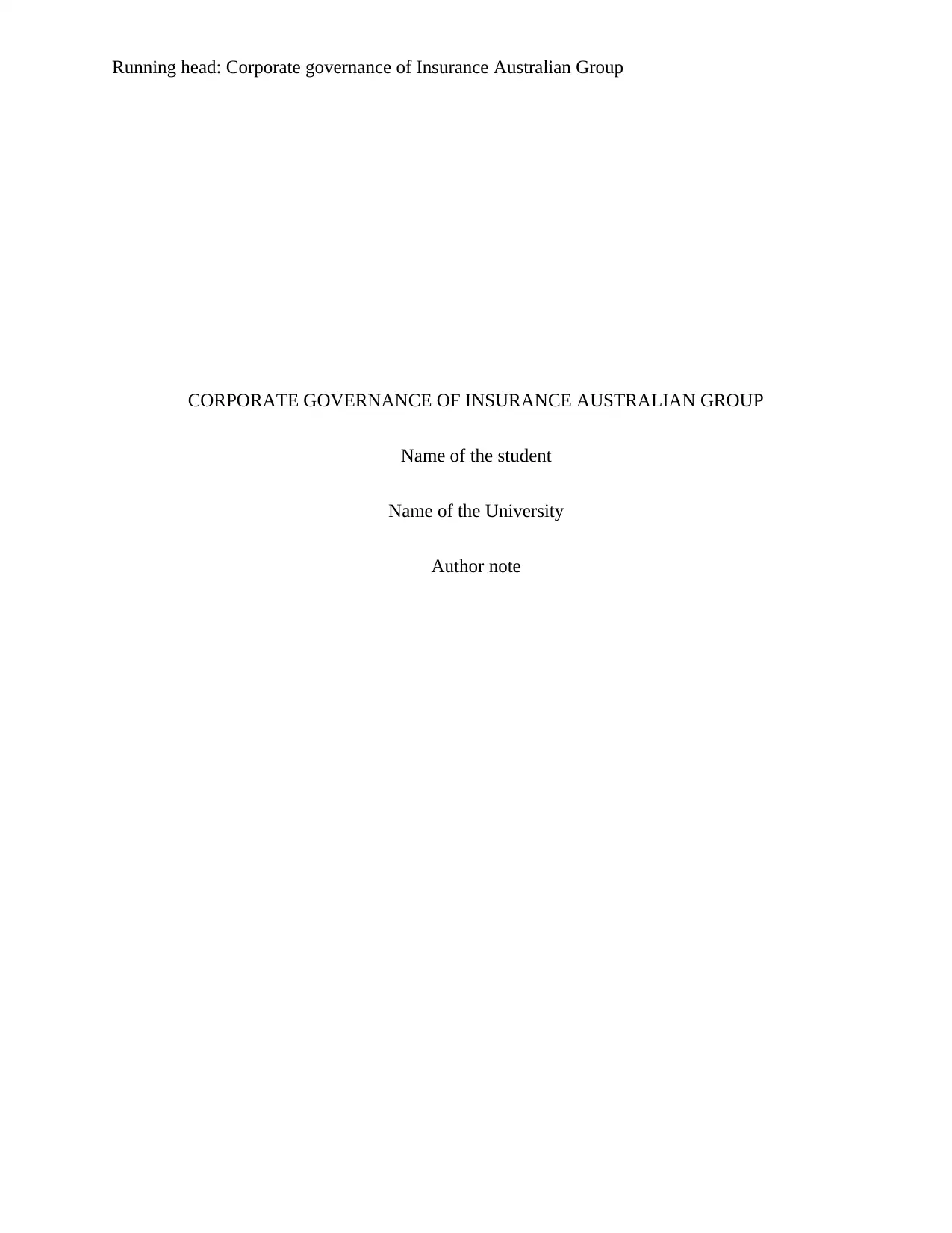
Running head: Corporate governance of Insurance Australian Group
CORPORATE GOVERNANCE OF INSURANCE AUSTRALIAN GROUP
Name of the student
Name of the University
Author note
CORPORATE GOVERNANCE OF INSURANCE AUSTRALIAN GROUP
Name of the student
Name of the University
Author note
Paraphrase This Document
Need a fresh take? Get an instant paraphrase of this document with our AI Paraphraser
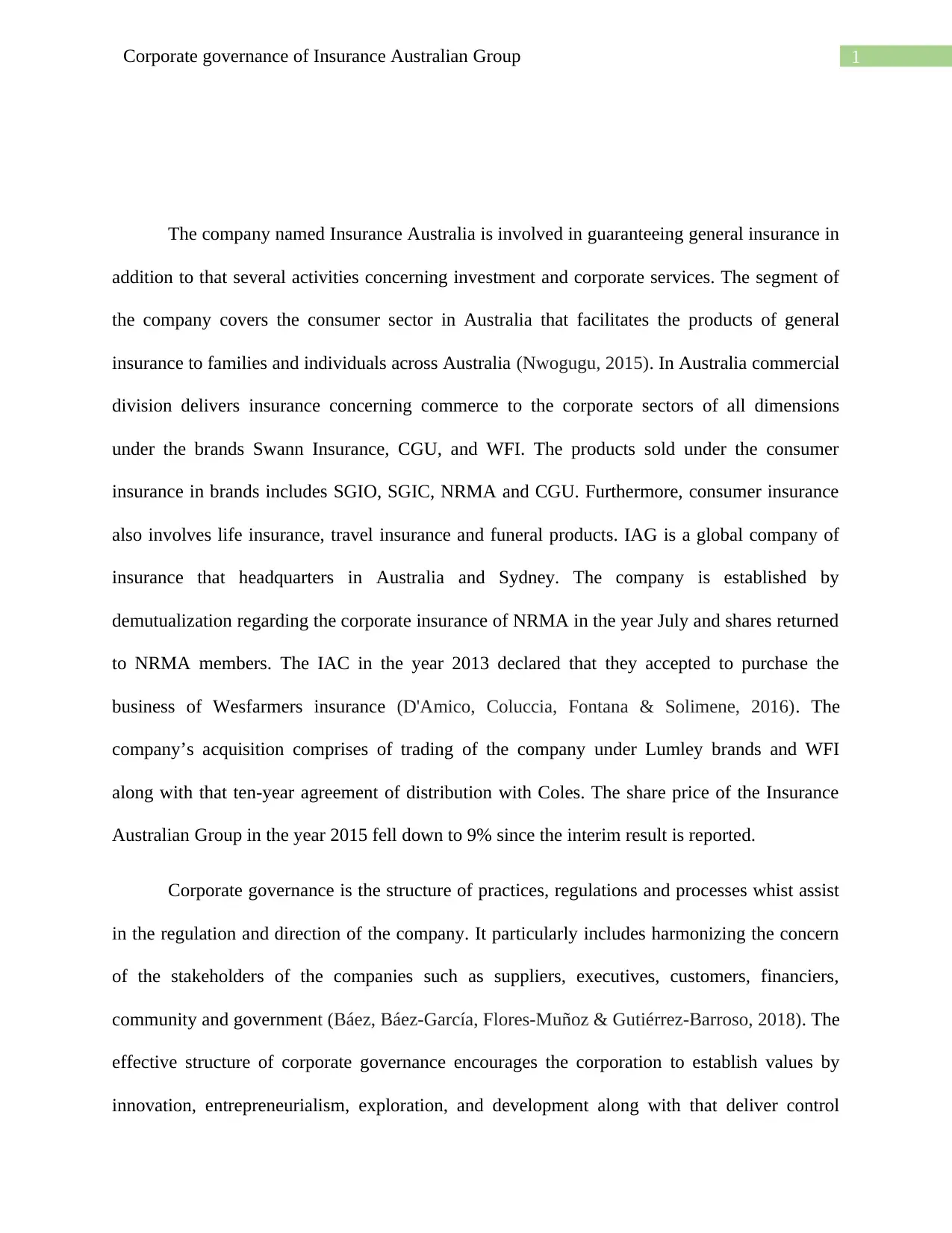
1Corporate governance of Insurance Australian Group
The company named Insurance Australia is involved in guaranteeing general insurance in
addition to that several activities concerning investment and corporate services. The segment of
the company covers the consumer sector in Australia that facilitates the products of general
insurance to families and individuals across Australia (Nwogugu, 2015). In Australia commercial
division delivers insurance concerning commerce to the corporate sectors of all dimensions
under the brands Swann Insurance, CGU, and WFI. The products sold under the consumer
insurance in brands includes SGIO, SGIC, NRMA and CGU. Furthermore, consumer insurance
also involves life insurance, travel insurance and funeral products. IAG is a global company of
insurance that headquarters in Australia and Sydney. The company is established by
demutualization regarding the corporate insurance of NRMA in the year July and shares returned
to NRMA members. The IAC in the year 2013 declared that they accepted to purchase the
business of Wesfarmers insurance (D'Amico, Coluccia, Fontana & Solimene, 2016). The
company’s acquisition comprises of trading of the company under Lumley brands and WFI
along with that ten-year agreement of distribution with Coles. The share price of the Insurance
Australian Group in the year 2015 fell down to 9% since the interim result is reported.
Corporate governance is the structure of practices, regulations and processes whist assist
in the regulation and direction of the company. It particularly includes harmonizing the concern
of the stakeholders of the companies such as suppliers, executives, customers, financiers,
community and government (Báez, Báez-García, Flores-Muñoz & Gutiérrez-Barroso, 2018). The
effective structure of corporate governance encourages the corporation to establish values by
innovation, entrepreneurialism, exploration, and development along with that deliver control
The company named Insurance Australia is involved in guaranteeing general insurance in
addition to that several activities concerning investment and corporate services. The segment of
the company covers the consumer sector in Australia that facilitates the products of general
insurance to families and individuals across Australia (Nwogugu, 2015). In Australia commercial
division delivers insurance concerning commerce to the corporate sectors of all dimensions
under the brands Swann Insurance, CGU, and WFI. The products sold under the consumer
insurance in brands includes SGIO, SGIC, NRMA and CGU. Furthermore, consumer insurance
also involves life insurance, travel insurance and funeral products. IAG is a global company of
insurance that headquarters in Australia and Sydney. The company is established by
demutualization regarding the corporate insurance of NRMA in the year July and shares returned
to NRMA members. The IAC in the year 2013 declared that they accepted to purchase the
business of Wesfarmers insurance (D'Amico, Coluccia, Fontana & Solimene, 2016). The
company’s acquisition comprises of trading of the company under Lumley brands and WFI
along with that ten-year agreement of distribution with Coles. The share price of the Insurance
Australian Group in the year 2015 fell down to 9% since the interim result is reported.
Corporate governance is the structure of practices, regulations and processes whist assist
in the regulation and direction of the company. It particularly includes harmonizing the concern
of the stakeholders of the companies such as suppliers, executives, customers, financiers,
community and government (Báez, Báez-García, Flores-Muñoz & Gutiérrez-Barroso, 2018). The
effective structure of corporate governance encourages the corporation to establish values by
innovation, entrepreneurialism, exploration, and development along with that deliver control
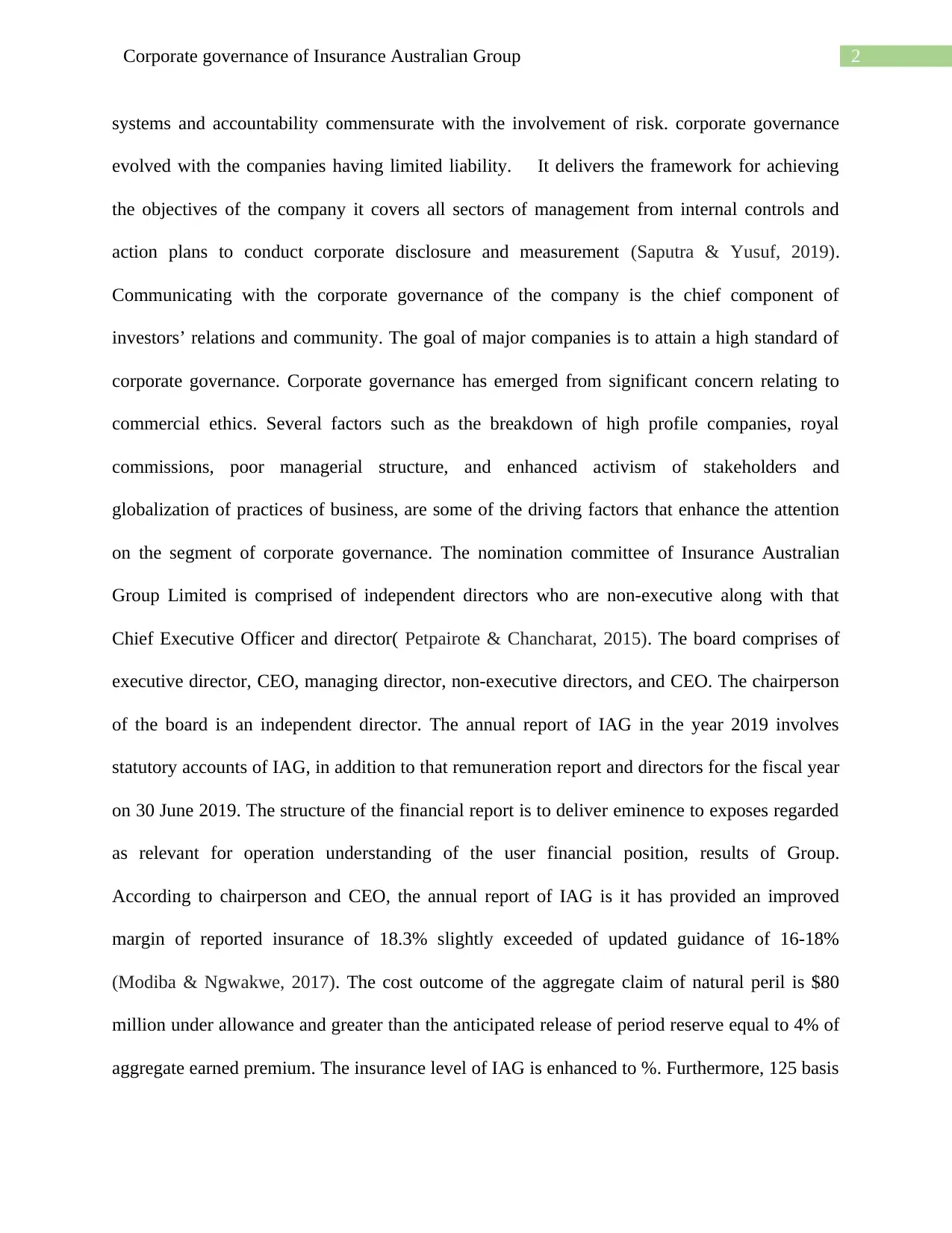
2Corporate governance of Insurance Australian Group
systems and accountability commensurate with the involvement of risk. corporate governance
evolved with the companies having limited liability. It delivers the framework for achieving
the objectives of the company it covers all sectors of management from internal controls and
action plans to conduct corporate disclosure and measurement (Saputra & Yusuf, 2019).
Communicating with the corporate governance of the company is the chief component of
investors’ relations and community. The goal of major companies is to attain a high standard of
corporate governance. Corporate governance has emerged from significant concern relating to
commercial ethics. Several factors such as the breakdown of high profile companies, royal
commissions, poor managerial structure, and enhanced activism of stakeholders and
globalization of practices of business, are some of the driving factors that enhance the attention
on the segment of corporate governance. The nomination committee of Insurance Australian
Group Limited is comprised of independent directors who are non-executive along with that
Chief Executive Officer and director( Petpairote & Chancharat, 2015). The board comprises of
executive director, CEO, managing director, non-executive directors, and CEO. The chairperson
of the board is an independent director. The annual report of IAG in the year 2019 involves
statutory accounts of IAG, in addition to that remuneration report and directors for the fiscal year
on 30 June 2019. The structure of the financial report is to deliver eminence to exposes regarded
as relevant for operation understanding of the user financial position, results of Group.
According to chairperson and CEO, the annual report of IAG is it has provided an improved
margin of reported insurance of 18.3% slightly exceeded of updated guidance of 16-18%
(Modiba & Ngwakwe, 2017). The cost outcome of the aggregate claim of natural peril is $80
million under allowance and greater than the anticipated release of period reserve equal to 4% of
aggregate earned premium. The insurance level of IAG is enhanced to %. Furthermore, 125 basis
systems and accountability commensurate with the involvement of risk. corporate governance
evolved with the companies having limited liability. It delivers the framework for achieving
the objectives of the company it covers all sectors of management from internal controls and
action plans to conduct corporate disclosure and measurement (Saputra & Yusuf, 2019).
Communicating with the corporate governance of the company is the chief component of
investors’ relations and community. The goal of major companies is to attain a high standard of
corporate governance. Corporate governance has emerged from significant concern relating to
commercial ethics. Several factors such as the breakdown of high profile companies, royal
commissions, poor managerial structure, and enhanced activism of stakeholders and
globalization of practices of business, are some of the driving factors that enhance the attention
on the segment of corporate governance. The nomination committee of Insurance Australian
Group Limited is comprised of independent directors who are non-executive along with that
Chief Executive Officer and director( Petpairote & Chancharat, 2015). The board comprises of
executive director, CEO, managing director, non-executive directors, and CEO. The chairperson
of the board is an independent director. The annual report of IAG in the year 2019 involves
statutory accounts of IAG, in addition to that remuneration report and directors for the fiscal year
on 30 June 2019. The structure of the financial report is to deliver eminence to exposes regarded
as relevant for operation understanding of the user financial position, results of Group.
According to chairperson and CEO, the annual report of IAG is it has provided an improved
margin of reported insurance of 18.3% slightly exceeded of updated guidance of 16-18%
(Modiba & Ngwakwe, 2017). The cost outcome of the aggregate claim of natural peril is $80
million under allowance and greater than the anticipated release of period reserve equal to 4% of
aggregate earned premium. The insurance level of IAG is enhanced to %. Furthermore, 125 basis
⊘ This is a preview!⊘
Do you want full access?
Subscribe today to unlock all pages.

Trusted by 1+ million students worldwide
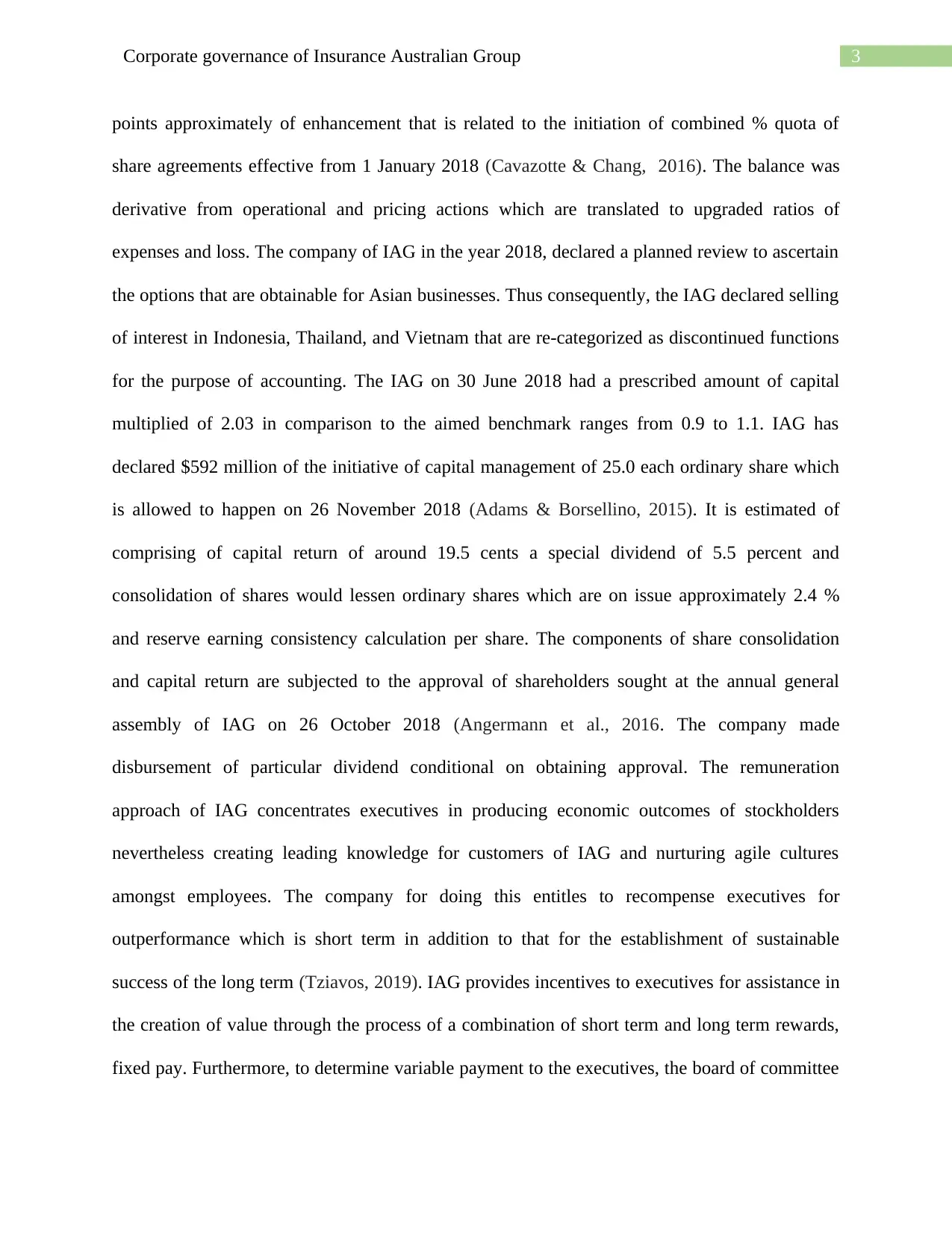
3Corporate governance of Insurance Australian Group
points approximately of enhancement that is related to the initiation of combined % quota of
share agreements effective from 1 January 2018 (Cavazotte & Chang, 2016). The balance was
derivative from operational and pricing actions which are translated to upgraded ratios of
expenses and loss. The company of IAG in the year 2018, declared a planned review to ascertain
the options that are obtainable for Asian businesses. Thus consequently, the IAG declared selling
of interest in Indonesia, Thailand, and Vietnam that are re-categorized as discontinued functions
for the purpose of accounting. The IAG on 30 June 2018 had a prescribed amount of capital
multiplied of 2.03 in comparison to the aimed benchmark ranges from 0.9 to 1.1. IAG has
declared $592 million of the initiative of capital management of 25.0 each ordinary share which
is allowed to happen on 26 November 2018 (Adams & Borsellino, 2015). It is estimated of
comprising of capital return of around 19.5 cents a special dividend of 5.5 percent and
consolidation of shares would lessen ordinary shares which are on issue approximately 2.4 %
and reserve earning consistency calculation per share. The components of share consolidation
and capital return are subjected to the approval of shareholders sought at the annual general
assembly of IAG on 26 October 2018 (Angermann et al., 2016. The company made
disbursement of particular dividend conditional on obtaining approval. The remuneration
approach of IAG concentrates executives in producing economic outcomes of stockholders
nevertheless creating leading knowledge for customers of IAG and nurturing agile cultures
amongst employees. The company for doing this entitles to recompense executives for
outperformance which is short term in addition to that for the establishment of sustainable
success of the long term (Tziavos, 2019). IAG provides incentives to executives for assistance in
the creation of value through the process of a combination of short term and long term rewards,
fixed pay. Furthermore, to determine variable payment to the executives, the board of committee
points approximately of enhancement that is related to the initiation of combined % quota of
share agreements effective from 1 January 2018 (Cavazotte & Chang, 2016). The balance was
derivative from operational and pricing actions which are translated to upgraded ratios of
expenses and loss. The company of IAG in the year 2018, declared a planned review to ascertain
the options that are obtainable for Asian businesses. Thus consequently, the IAG declared selling
of interest in Indonesia, Thailand, and Vietnam that are re-categorized as discontinued functions
for the purpose of accounting. The IAG on 30 June 2018 had a prescribed amount of capital
multiplied of 2.03 in comparison to the aimed benchmark ranges from 0.9 to 1.1. IAG has
declared $592 million of the initiative of capital management of 25.0 each ordinary share which
is allowed to happen on 26 November 2018 (Adams & Borsellino, 2015). It is estimated of
comprising of capital return of around 19.5 cents a special dividend of 5.5 percent and
consolidation of shares would lessen ordinary shares which are on issue approximately 2.4 %
and reserve earning consistency calculation per share. The components of share consolidation
and capital return are subjected to the approval of shareholders sought at the annual general
assembly of IAG on 26 October 2018 (Angermann et al., 2016. The company made
disbursement of particular dividend conditional on obtaining approval. The remuneration
approach of IAG concentrates executives in producing economic outcomes of stockholders
nevertheless creating leading knowledge for customers of IAG and nurturing agile cultures
amongst employees. The company for doing this entitles to recompense executives for
outperformance which is short term in addition to that for the establishment of sustainable
success of the long term (Tziavos, 2019). IAG provides incentives to executives for assistance in
the creation of value through the process of a combination of short term and long term rewards,
fixed pay. Furthermore, to determine variable payment to the executives, the board of committee
Paraphrase This Document
Need a fresh take? Get an instant paraphrase of this document with our AI Paraphraser
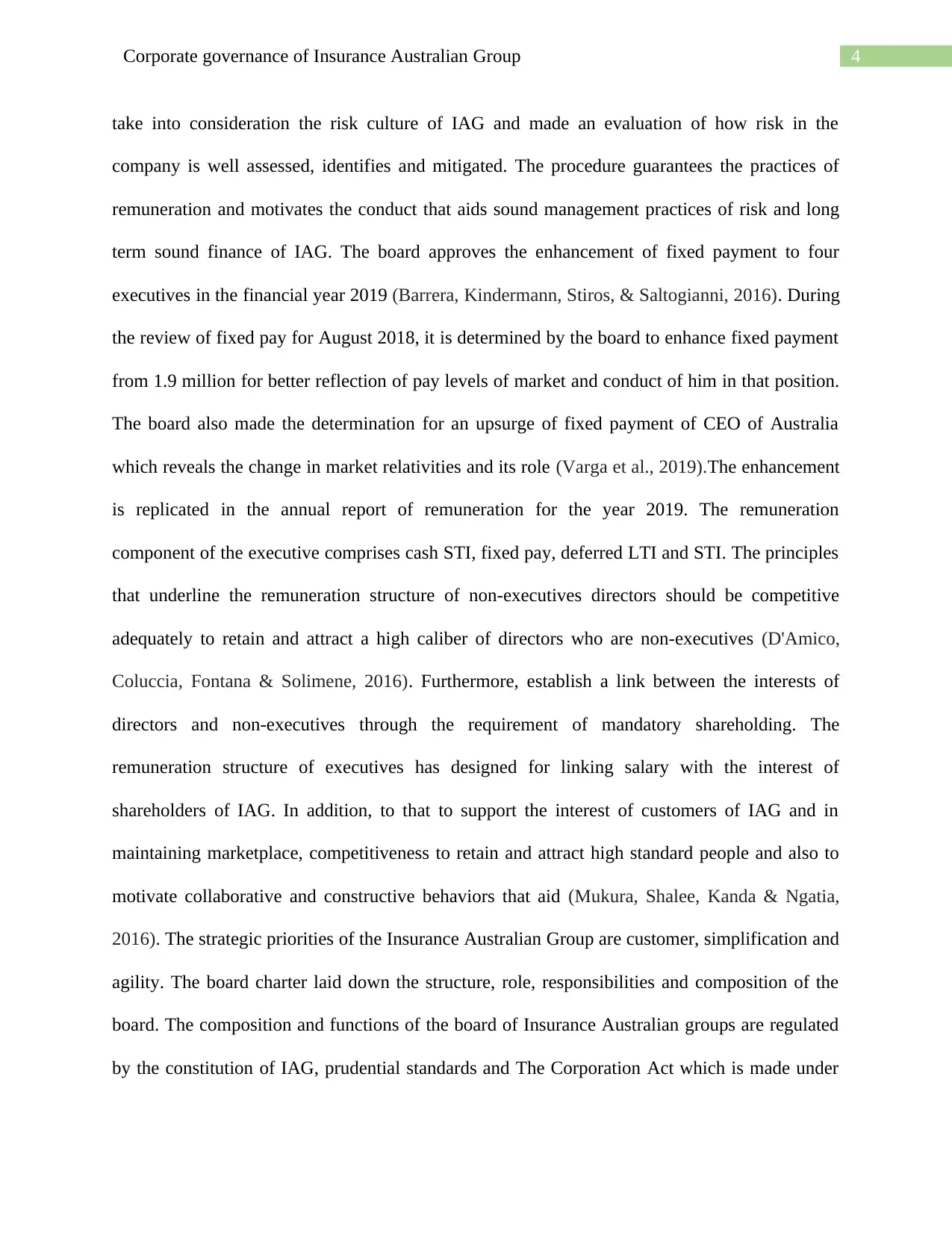
4Corporate governance of Insurance Australian Group
take into consideration the risk culture of IAG and made an evaluation of how risk in the
company is well assessed, identifies and mitigated. The procedure guarantees the practices of
remuneration and motivates the conduct that aids sound management practices of risk and long
term sound finance of IAG. The board approves the enhancement of fixed payment to four
executives in the financial year 2019 (Barrera, Kindermann, Stiros, & Saltogianni, 2016). During
the review of fixed pay for August 2018, it is determined by the board to enhance fixed payment
from 1.9 million for better reflection of pay levels of market and conduct of him in that position.
The board also made the determination for an upsurge of fixed payment of CEO of Australia
which reveals the change in market relativities and its role (Varga et al., 2019).The enhancement
is replicated in the annual report of remuneration for the year 2019. The remuneration
component of the executive comprises cash STI, fixed pay, deferred LTI and STI. The principles
that underline the remuneration structure of non-executives directors should be competitive
adequately to retain and attract a high caliber of directors who are non-executives (D'Amico,
Coluccia, Fontana & Solimene, 2016). Furthermore, establish a link between the interests of
directors and non-executives through the requirement of mandatory shareholding. The
remuneration structure of executives has designed for linking salary with the interest of
shareholders of IAG. In addition, to that to support the interest of customers of IAG and in
maintaining marketplace, competitiveness to retain and attract high standard people and also to
motivate collaborative and constructive behaviors that aid (Mukura, Shalee, Kanda & Ngatia,
2016). The strategic priorities of the Insurance Australian Group are customer, simplification and
agility. The board charter laid down the structure, role, responsibilities and composition of the
board. The composition and functions of the board of Insurance Australian groups are regulated
by the constitution of IAG, prudential standards and The Corporation Act which is made under
take into consideration the risk culture of IAG and made an evaluation of how risk in the
company is well assessed, identifies and mitigated. The procedure guarantees the practices of
remuneration and motivates the conduct that aids sound management practices of risk and long
term sound finance of IAG. The board approves the enhancement of fixed payment to four
executives in the financial year 2019 (Barrera, Kindermann, Stiros, & Saltogianni, 2016). During
the review of fixed pay for August 2018, it is determined by the board to enhance fixed payment
from 1.9 million for better reflection of pay levels of market and conduct of him in that position.
The board also made the determination for an upsurge of fixed payment of CEO of Australia
which reveals the change in market relativities and its role (Varga et al., 2019).The enhancement
is replicated in the annual report of remuneration for the year 2019. The remuneration
component of the executive comprises cash STI, fixed pay, deferred LTI and STI. The principles
that underline the remuneration structure of non-executives directors should be competitive
adequately to retain and attract a high caliber of directors who are non-executives (D'Amico,
Coluccia, Fontana & Solimene, 2016). Furthermore, establish a link between the interests of
directors and non-executives through the requirement of mandatory shareholding. The
remuneration structure of executives has designed for linking salary with the interest of
shareholders of IAG. In addition, to that to support the interest of customers of IAG and in
maintaining marketplace, competitiveness to retain and attract high standard people and also to
motivate collaborative and constructive behaviors that aid (Mukura, Shalee, Kanda & Ngatia,
2016). The strategic priorities of the Insurance Australian Group are customer, simplification and
agility. The board charter laid down the structure, role, responsibilities and composition of the
board. The composition and functions of the board of Insurance Australian groups are regulated
by the constitution of IAG, prudential standards and The Corporation Act which is made under
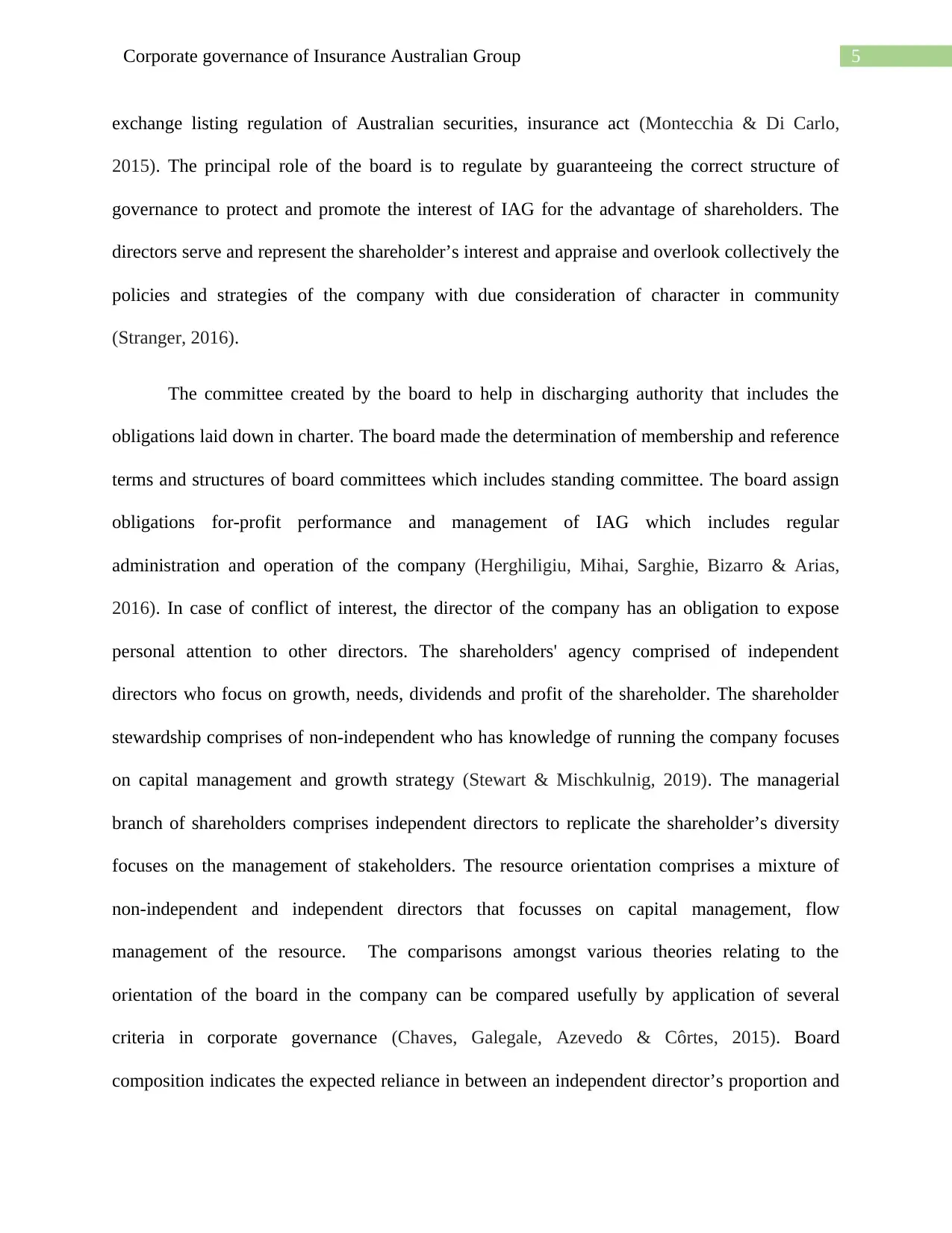
5Corporate governance of Insurance Australian Group
exchange listing regulation of Australian securities, insurance act (Montecchia & Di Carlo,
2015). The principal role of the board is to regulate by guaranteeing the correct structure of
governance to protect and promote the interest of IAG for the advantage of shareholders. The
directors serve and represent the shareholder’s interest and appraise and overlook collectively the
policies and strategies of the company with due consideration of character in community
(Stranger, 2016).
The committee created by the board to help in discharging authority that includes the
obligations laid down in charter. The board made the determination of membership and reference
terms and structures of board committees which includes standing committee. The board assign
obligations for-profit performance and management of IAG which includes regular
administration and operation of the company (Herghiligiu, Mihai, Sarghie, Bizarro & Arias,
2016). In case of conflict of interest, the director of the company has an obligation to expose
personal attention to other directors. The shareholders' agency comprised of independent
directors who focus on growth, needs, dividends and profit of the shareholder. The shareholder
stewardship comprises of non-independent who has knowledge of running the company focuses
on capital management and growth strategy (Stewart & Mischkulnig, 2019). The managerial
branch of shareholders comprises independent directors to replicate the shareholder’s diversity
focuses on the management of stakeholders. The resource orientation comprises a mixture of
non-independent and independent directors that focusses on capital management, flow
management of the resource. The comparisons amongst various theories relating to the
orientation of the board in the company can be compared usefully by application of several
criteria in corporate governance (Chaves, Galegale, Azevedo & Côrtes, 2015). Board
composition indicates the expected reliance in between an independent director’s proportion and
exchange listing regulation of Australian securities, insurance act (Montecchia & Di Carlo,
2015). The principal role of the board is to regulate by guaranteeing the correct structure of
governance to protect and promote the interest of IAG for the advantage of shareholders. The
directors serve and represent the shareholder’s interest and appraise and overlook collectively the
policies and strategies of the company with due consideration of character in community
(Stranger, 2016).
The committee created by the board to help in discharging authority that includes the
obligations laid down in charter. The board made the determination of membership and reference
terms and structures of board committees which includes standing committee. The board assign
obligations for-profit performance and management of IAG which includes regular
administration and operation of the company (Herghiligiu, Mihai, Sarghie, Bizarro & Arias,
2016). In case of conflict of interest, the director of the company has an obligation to expose
personal attention to other directors. The shareholders' agency comprised of independent
directors who focus on growth, needs, dividends and profit of the shareholder. The shareholder
stewardship comprises of non-independent who has knowledge of running the company focuses
on capital management and growth strategy (Stewart & Mischkulnig, 2019). The managerial
branch of shareholders comprises independent directors to replicate the shareholder’s diversity
focuses on the management of stakeholders. The resource orientation comprises a mixture of
non-independent and independent directors that focusses on capital management, flow
management of the resource. The comparisons amongst various theories relating to the
orientation of the board in the company can be compared usefully by application of several
criteria in corporate governance (Chaves, Galegale, Azevedo & Côrtes, 2015). Board
composition indicates the expected reliance in between an independent director’s proportion and
⊘ This is a preview!⊘
Do you want full access?
Subscribe today to unlock all pages.

Trusted by 1+ million students worldwide
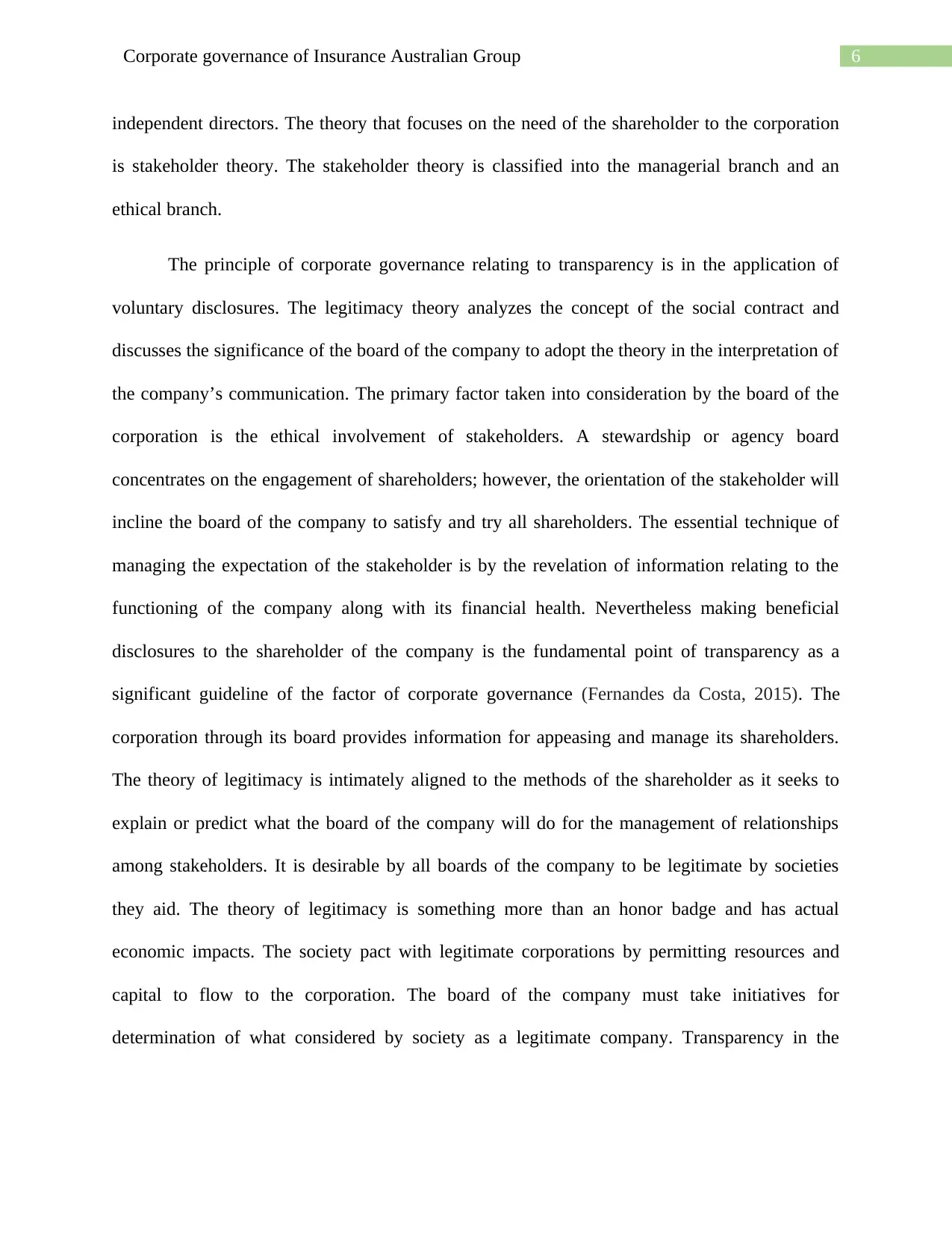
6Corporate governance of Insurance Australian Group
independent directors. The theory that focuses on the need of the shareholder to the corporation
is stakeholder theory. The stakeholder theory is classified into the managerial branch and an
ethical branch.
The principle of corporate governance relating to transparency is in the application of
voluntary disclosures. The legitimacy theory analyzes the concept of the social contract and
discusses the significance of the board of the company to adopt the theory in the interpretation of
the company’s communication. The primary factor taken into consideration by the board of the
corporation is the ethical involvement of stakeholders. A stewardship or agency board
concentrates on the engagement of shareholders; however, the orientation of the stakeholder will
incline the board of the company to satisfy and try all shareholders. The essential technique of
managing the expectation of the stakeholder is by the revelation of information relating to the
functioning of the company along with its financial health. Nevertheless making beneficial
disclosures to the shareholder of the company is the fundamental point of transparency as a
significant guideline of the factor of corporate governance (Fernandes da Costa, 2015). The
corporation through its board provides information for appeasing and manage its shareholders.
The theory of legitimacy is intimately aligned to the methods of the shareholder as it seeks to
explain or predict what the board of the company will do for the management of relationships
among stakeholders. It is desirable by all boards of the company to be legitimate by societies
they aid. The theory of legitimacy is something more than an honor badge and has actual
economic impacts. The society pact with legitimate corporations by permitting resources and
capital to flow to the corporation. The board of the company must take initiatives for
determination of what considered by society as a legitimate company. Transparency in the
independent directors. The theory that focuses on the need of the shareholder to the corporation
is stakeholder theory. The stakeholder theory is classified into the managerial branch and an
ethical branch.
The principle of corporate governance relating to transparency is in the application of
voluntary disclosures. The legitimacy theory analyzes the concept of the social contract and
discusses the significance of the board of the company to adopt the theory in the interpretation of
the company’s communication. The primary factor taken into consideration by the board of the
corporation is the ethical involvement of stakeholders. A stewardship or agency board
concentrates on the engagement of shareholders; however, the orientation of the stakeholder will
incline the board of the company to satisfy and try all shareholders. The essential technique of
managing the expectation of the stakeholder is by the revelation of information relating to the
functioning of the company along with its financial health. Nevertheless making beneficial
disclosures to the shareholder of the company is the fundamental point of transparency as a
significant guideline of the factor of corporate governance (Fernandes da Costa, 2015). The
corporation through its board provides information for appeasing and manage its shareholders.
The theory of legitimacy is intimately aligned to the methods of the shareholder as it seeks to
explain or predict what the board of the company will do for the management of relationships
among stakeholders. It is desirable by all boards of the company to be legitimate by societies
they aid. The theory of legitimacy is something more than an honor badge and has actual
economic impacts. The society pact with legitimate corporations by permitting resources and
capital to flow to the corporation. The board of the company must take initiatives for
determination of what considered by society as a legitimate company. Transparency in the
Paraphrase This Document
Need a fresh take? Get an instant paraphrase of this document with our AI Paraphraser
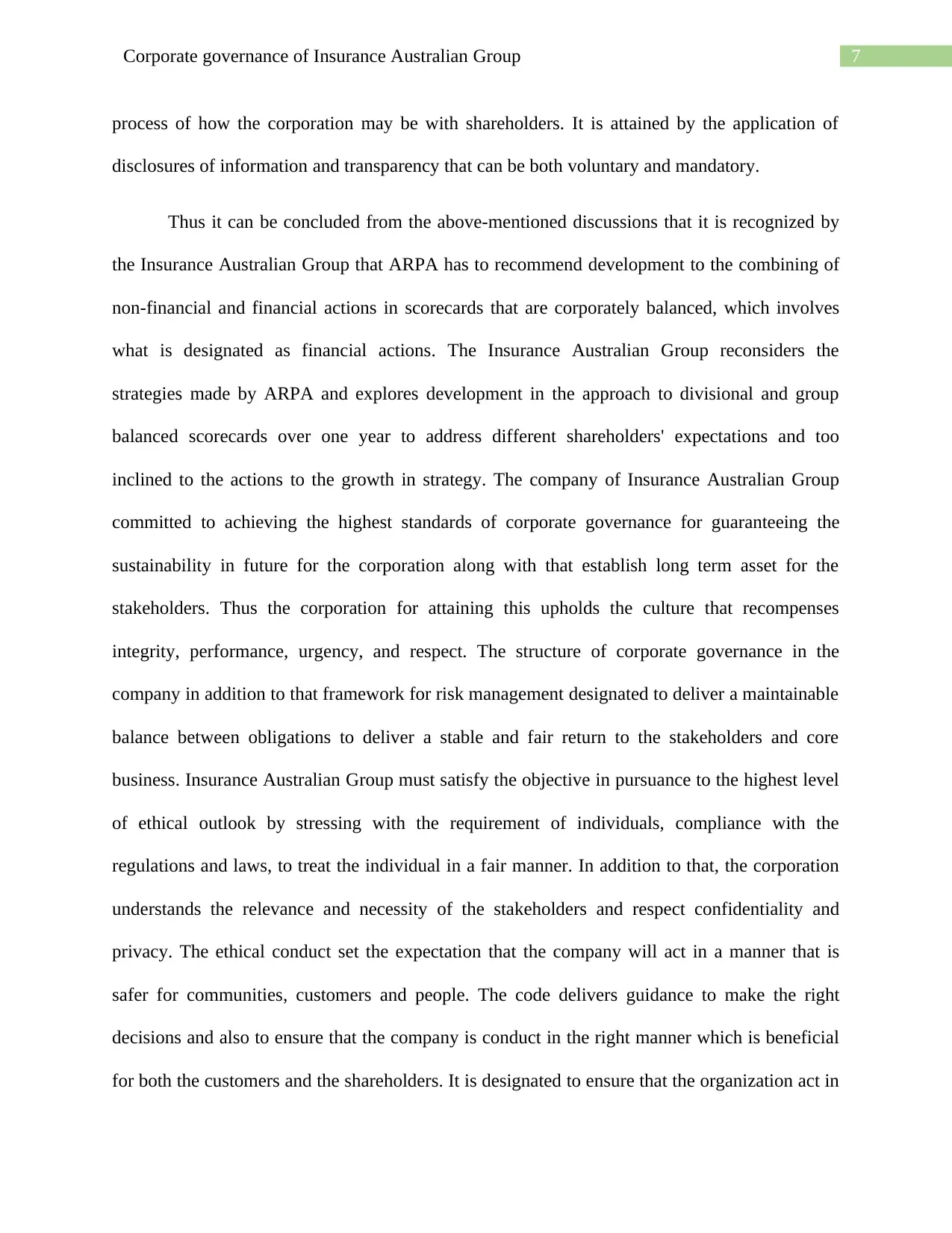
7Corporate governance of Insurance Australian Group
process of how the corporation may be with shareholders. It is attained by the application of
disclosures of information and transparency that can be both voluntary and mandatory.
Thus it can be concluded from the above-mentioned discussions that it is recognized by
the Insurance Australian Group that ARPA has to recommend development to the combining of
non-financial and financial actions in scorecards that are corporately balanced, which involves
what is designated as financial actions. The Insurance Australian Group reconsiders the
strategies made by ARPA and explores development in the approach to divisional and group
balanced scorecards over one year to address different shareholders' expectations and too
inclined to the actions to the growth in strategy. The company of Insurance Australian Group
committed to achieving the highest standards of corporate governance for guaranteeing the
sustainability in future for the corporation along with that establish long term asset for the
stakeholders. Thus the corporation for attaining this upholds the culture that recompenses
integrity, performance, urgency, and respect. The structure of corporate governance in the
company in addition to that framework for risk management designated to deliver a maintainable
balance between obligations to deliver a stable and fair return to the stakeholders and core
business. Insurance Australian Group must satisfy the objective in pursuance to the highest level
of ethical outlook by stressing with the requirement of individuals, compliance with the
regulations and laws, to treat the individual in a fair manner. In addition to that, the corporation
understands the relevance and necessity of the stakeholders and respect confidentiality and
privacy. The ethical conduct set the expectation that the company will act in a manner that is
safer for communities, customers and people. The code delivers guidance to make the right
decisions and also to ensure that the company is conduct in the right manner which is beneficial
for both the customers and the shareholders. It is designated to ensure that the organization act in
process of how the corporation may be with shareholders. It is attained by the application of
disclosures of information and transparency that can be both voluntary and mandatory.
Thus it can be concluded from the above-mentioned discussions that it is recognized by
the Insurance Australian Group that ARPA has to recommend development to the combining of
non-financial and financial actions in scorecards that are corporately balanced, which involves
what is designated as financial actions. The Insurance Australian Group reconsiders the
strategies made by ARPA and explores development in the approach to divisional and group
balanced scorecards over one year to address different shareholders' expectations and too
inclined to the actions to the growth in strategy. The company of Insurance Australian Group
committed to achieving the highest standards of corporate governance for guaranteeing the
sustainability in future for the corporation along with that establish long term asset for the
stakeholders. Thus the corporation for attaining this upholds the culture that recompenses
integrity, performance, urgency, and respect. The structure of corporate governance in the
company in addition to that framework for risk management designated to deliver a maintainable
balance between obligations to deliver a stable and fair return to the stakeholders and core
business. Insurance Australian Group must satisfy the objective in pursuance to the highest level
of ethical outlook by stressing with the requirement of individuals, compliance with the
regulations and laws, to treat the individual in a fair manner. In addition to that, the corporation
understands the relevance and necessity of the stakeholders and respect confidentiality and
privacy. The ethical conduct set the expectation that the company will act in a manner that is
safer for communities, customers and people. The code delivers guidance to make the right
decisions and also to ensure that the company is conduct in the right manner which is beneficial
for both the customers and the shareholders. It is designated to ensure that the organization act in
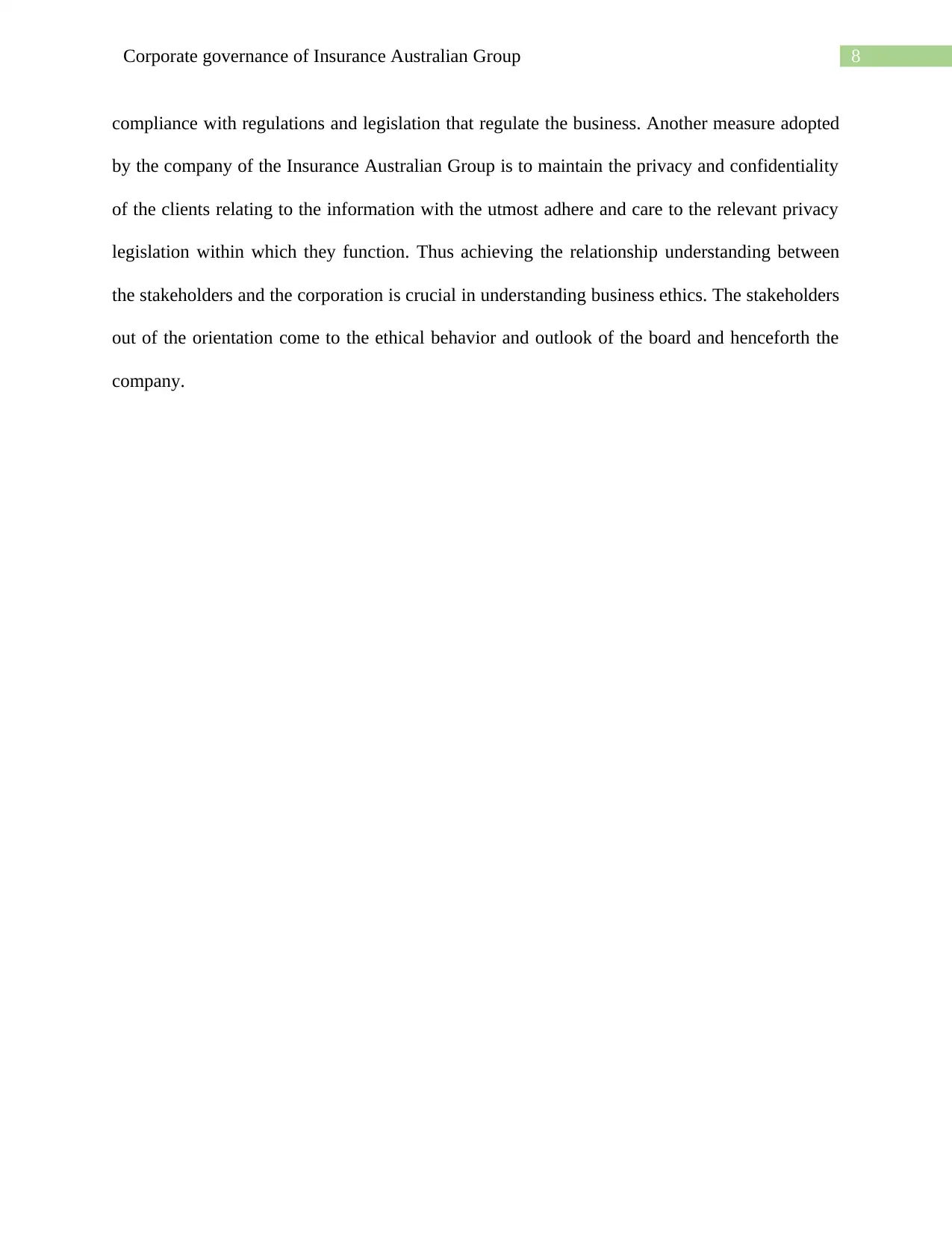
8Corporate governance of Insurance Australian Group
compliance with regulations and legislation that regulate the business. Another measure adopted
by the company of the Insurance Australian Group is to maintain the privacy and confidentiality
of the clients relating to the information with the utmost adhere and care to the relevant privacy
legislation within which they function. Thus achieving the relationship understanding between
the stakeholders and the corporation is crucial in understanding business ethics. The stakeholders
out of the orientation come to the ethical behavior and outlook of the board and henceforth the
company.
compliance with regulations and legislation that regulate the business. Another measure adopted
by the company of the Insurance Australian Group is to maintain the privacy and confidentiality
of the clients relating to the information with the utmost adhere and care to the relevant privacy
legislation within which they function. Thus achieving the relationship understanding between
the stakeholders and the corporation is crucial in understanding business ethics. The stakeholders
out of the orientation come to the ethical behavior and outlook of the board and henceforth the
company.
⊘ This is a preview!⊘
Do you want full access?
Subscribe today to unlock all pages.

Trusted by 1+ million students worldwide

9Corporate governance of Insurance Australian Group
Paraphrase This Document
Need a fresh take? Get an instant paraphrase of this document with our AI Paraphraser
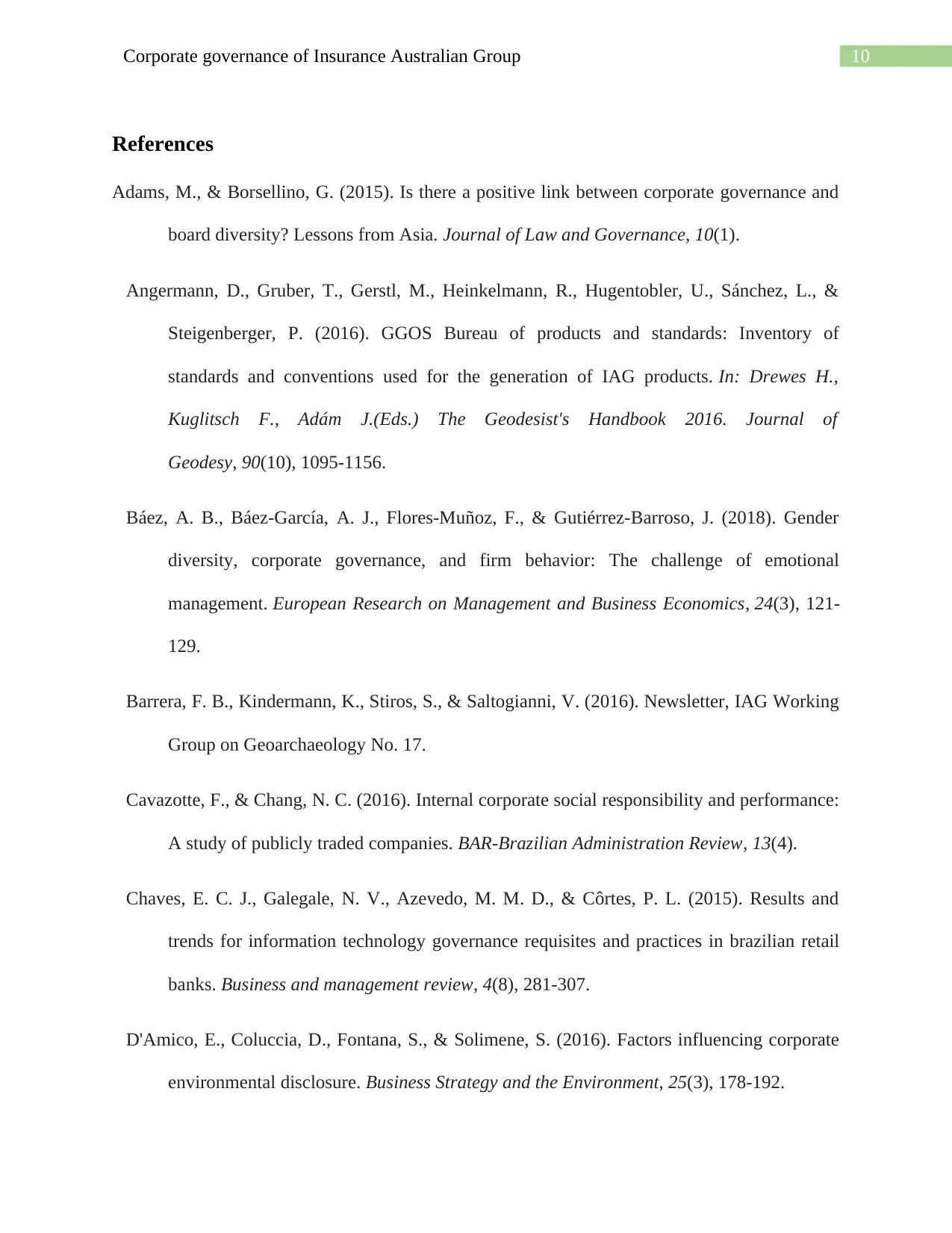
10Corporate governance of Insurance Australian Group
References
Adams, M., & Borsellino, G. (2015). Is there a positive link between corporate governance and
board diversity? Lessons from Asia. Journal of Law and Governance, 10(1).
Angermann, D., Gruber, T., Gerstl, M., Heinkelmann, R., Hugentobler, U., Sánchez, L., &
Steigenberger, P. (2016). GGOS Bureau of products and standards: Inventory of
standards and conventions used for the generation of IAG products. In: Drewes H.,
Kuglitsch F., Adám J.(Eds.) The Geodesist's Handbook 2016. Journal of
Geodesy, 90(10), 1095-1156.
Báez, A. B., Báez-García, A. J., Flores-Muñoz, F., & Gutiérrez-Barroso, J. (2018). Gender
diversity, corporate governance, and firm behavior: The challenge of emotional
management. European Research on Management and Business Economics, 24(3), 121-
129.
Barrera, F. B., Kindermann, K., Stiros, S., & Saltogianni, V. (2016). Newsletter, IAG Working
Group on Geoarchaeology No. 17.
Cavazotte, F., & Chang, N. C. (2016). Internal corporate social responsibility and performance:
A study of publicly traded companies. BAR-Brazilian Administration Review, 13(4).
Chaves, E. C. J., Galegale, N. V., Azevedo, M. M. D., & Côrtes, P. L. (2015). Results and
trends for information technology governance requisites and practices in brazilian retail
banks. Business and management review, 4(8), 281-307.
D'Amico, E., Coluccia, D., Fontana, S., & Solimene, S. (2016). Factors influencing corporate
environmental disclosure. Business Strategy and the Environment, 25(3), 178-192.
References
Adams, M., & Borsellino, G. (2015). Is there a positive link between corporate governance and
board diversity? Lessons from Asia. Journal of Law and Governance, 10(1).
Angermann, D., Gruber, T., Gerstl, M., Heinkelmann, R., Hugentobler, U., Sánchez, L., &
Steigenberger, P. (2016). GGOS Bureau of products and standards: Inventory of
standards and conventions used for the generation of IAG products. In: Drewes H.,
Kuglitsch F., Adám J.(Eds.) The Geodesist's Handbook 2016. Journal of
Geodesy, 90(10), 1095-1156.
Báez, A. B., Báez-García, A. J., Flores-Muñoz, F., & Gutiérrez-Barroso, J. (2018). Gender
diversity, corporate governance, and firm behavior: The challenge of emotional
management. European Research on Management and Business Economics, 24(3), 121-
129.
Barrera, F. B., Kindermann, K., Stiros, S., & Saltogianni, V. (2016). Newsletter, IAG Working
Group on Geoarchaeology No. 17.
Cavazotte, F., & Chang, N. C. (2016). Internal corporate social responsibility and performance:
A study of publicly traded companies. BAR-Brazilian Administration Review, 13(4).
Chaves, E. C. J., Galegale, N. V., Azevedo, M. M. D., & Côrtes, P. L. (2015). Results and
trends for information technology governance requisites and practices in brazilian retail
banks. Business and management review, 4(8), 281-307.
D'Amico, E., Coluccia, D., Fontana, S., & Solimene, S. (2016). Factors influencing corporate
environmental disclosure. Business Strategy and the Environment, 25(3), 178-192.
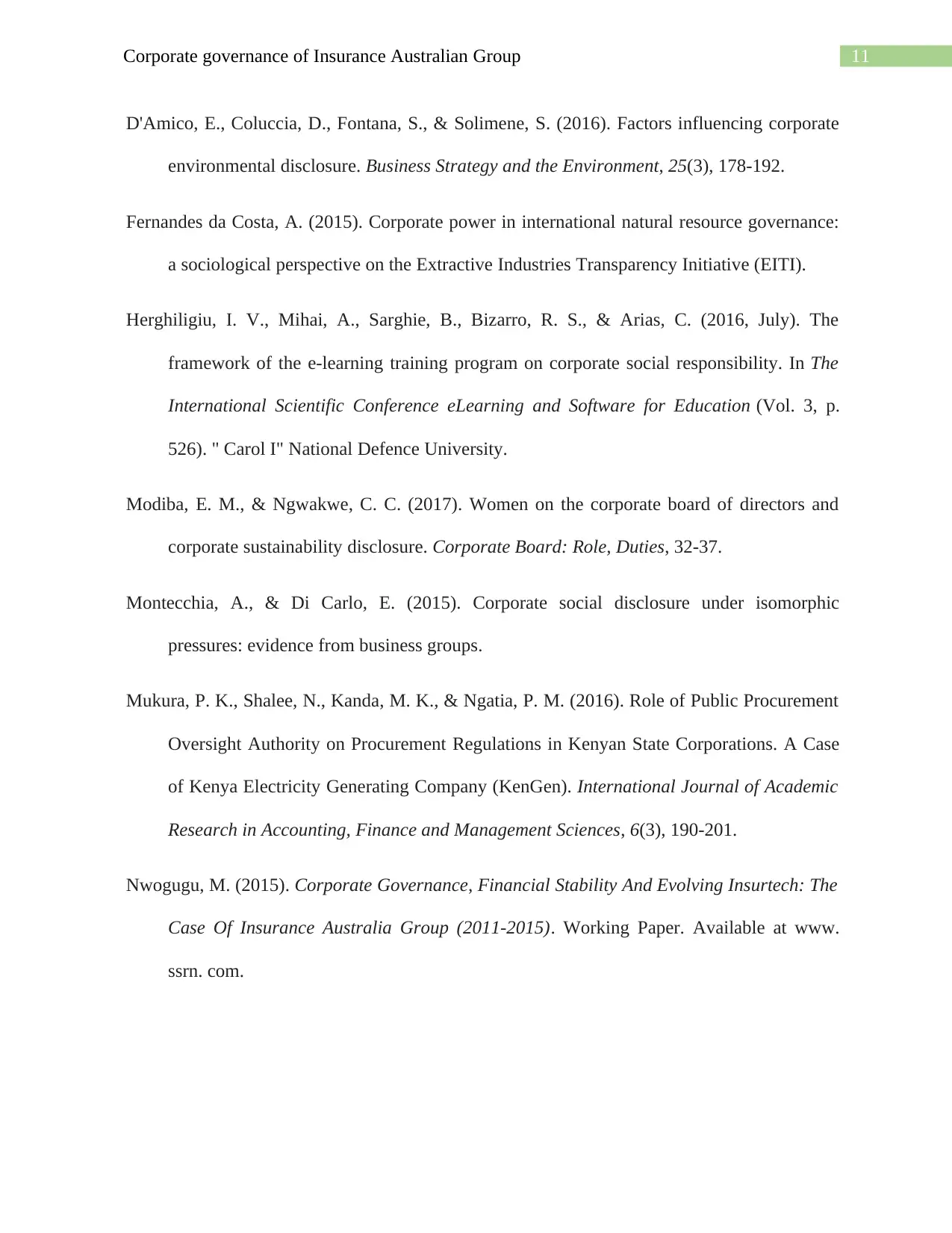
11Corporate governance of Insurance Australian Group
D'Amico, E., Coluccia, D., Fontana, S., & Solimene, S. (2016). Factors influencing corporate
environmental disclosure. Business Strategy and the Environment, 25(3), 178-192.
Fernandes da Costa, A. (2015). Corporate power in international natural resource governance:
a sociological perspective on the Extractive Industries Transparency Initiative (EITI).
Herghiligiu, I. V., Mihai, A., Sarghie, B., Bizarro, R. S., & Arias, C. (2016, July). The
framework of the e-learning training program on corporate social responsibility. In The
International Scientific Conference eLearning and Software for Education (Vol. 3, p.
526). " Carol I" National Defence University.
Modiba, E. M., & Ngwakwe, C. C. (2017). Women on the corporate board of directors and
corporate sustainability disclosure. Corporate Board: Role, Duties, 32-37.
Montecchia, A., & Di Carlo, E. (2015). Corporate social disclosure under isomorphic
pressures: evidence from business groups.
Mukura, P. K., Shalee, N., Kanda, M. K., & Ngatia, P. M. (2016). Role of Public Procurement
Oversight Authority on Procurement Regulations in Kenyan State Corporations. A Case
of Kenya Electricity Generating Company (KenGen). International Journal of Academic
Research in Accounting, Finance and Management Sciences, 6(3), 190-201.
Nwogugu, M. (2015). Corporate Governance, Financial Stability And Evolving Insurtech: The
Case Of Insurance Australia Group (2011-2015). Working Paper. Available at www.
ssrn. com.
D'Amico, E., Coluccia, D., Fontana, S., & Solimene, S. (2016). Factors influencing corporate
environmental disclosure. Business Strategy and the Environment, 25(3), 178-192.
Fernandes da Costa, A. (2015). Corporate power in international natural resource governance:
a sociological perspective on the Extractive Industries Transparency Initiative (EITI).
Herghiligiu, I. V., Mihai, A., Sarghie, B., Bizarro, R. S., & Arias, C. (2016, July). The
framework of the e-learning training program on corporate social responsibility. In The
International Scientific Conference eLearning and Software for Education (Vol. 3, p.
526). " Carol I" National Defence University.
Modiba, E. M., & Ngwakwe, C. C. (2017). Women on the corporate board of directors and
corporate sustainability disclosure. Corporate Board: Role, Duties, 32-37.
Montecchia, A., & Di Carlo, E. (2015). Corporate social disclosure under isomorphic
pressures: evidence from business groups.
Mukura, P. K., Shalee, N., Kanda, M. K., & Ngatia, P. M. (2016). Role of Public Procurement
Oversight Authority on Procurement Regulations in Kenyan State Corporations. A Case
of Kenya Electricity Generating Company (KenGen). International Journal of Academic
Research in Accounting, Finance and Management Sciences, 6(3), 190-201.
Nwogugu, M. (2015). Corporate Governance, Financial Stability And Evolving Insurtech: The
Case Of Insurance Australia Group (2011-2015). Working Paper. Available at www.
ssrn. com.
⊘ This is a preview!⊘
Do you want full access?
Subscribe today to unlock all pages.

Trusted by 1+ million students worldwide
1 out of 13
Related Documents
Your All-in-One AI-Powered Toolkit for Academic Success.
+13062052269
info@desklib.com
Available 24*7 on WhatsApp / Email
![[object Object]](/_next/static/media/star-bottom.7253800d.svg)
Unlock your academic potential
Copyright © 2020–2025 A2Z Services. All Rights Reserved. Developed and managed by ZUCOL.





